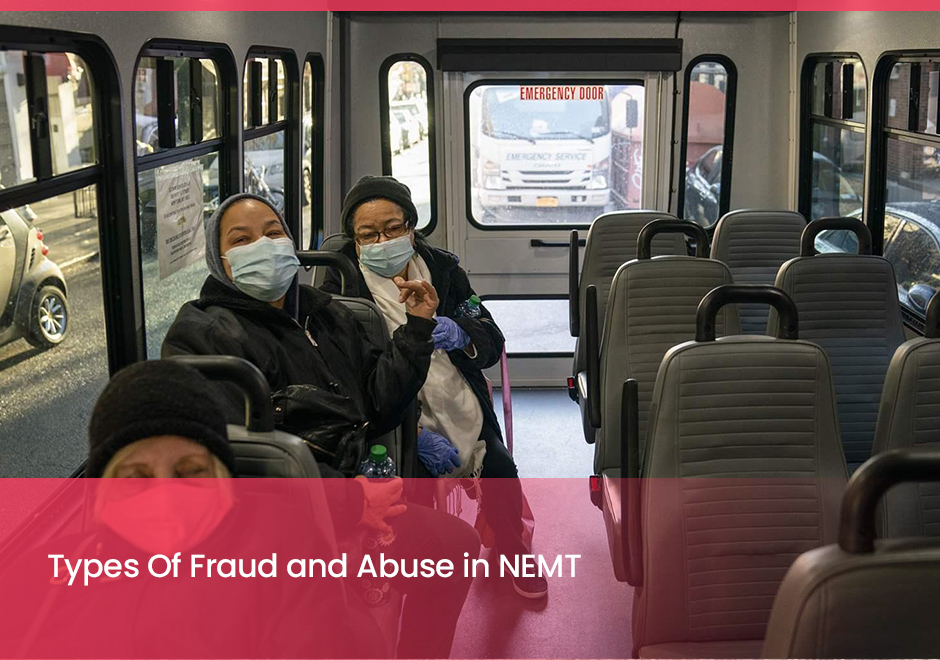New At Safr Care
TYPES OF FRAUD AND ABUSE IN NEMT

Since the COVID-19 pandemic, fraudulent activities including abuse and scams have increased across multiple industries, and the non-emergency medical transportation (NEMT) industry has had its share of such incidents. Fraud and abuse are a concern for patients, providers and the ecosystem as they can span across multiple categories, such as billing discrepancies (including unauthorized billing), false reporting of services, unnecessary tests or treatments, using unauthorized vehicles, and more. These activities can lead to patients not receiving the proper and timely care that they need. Here is a look at some of the most prevalent types of fraud and abuse in the NEMT industry: Billing for Services Not Rendered When patients or insurance providers are billed for trips that never actually occurred; this can also include billing for an additional attendant (i.e., a beneficiary caretaker) when none was provided. Unspecified Overbilling Providers may engage in deceptive billing practices to receive excess payment, whereby they are misrepresenting actual trips and services. Upcharging Upcharge billing occurs for charging for an attendant when one was not necessary. Upcharge billing occurs when billing for an ambulance when a less expensive form of transportation could have been used. Another form of upcharging occurs when providers bill for non ambulatory support services when the beneficiary was ambulatory. Undocumented Trips and/or Forged Documents Missing and forged supporting documentation of trips, including transportation provider trip logs, signed certificates of medical necessity, and signed transportation vouchers, are all forms of fraud. Billing for Excess Mileage An example of excess billing mileage is when providers bill for a 30-mile trip when a 15-mile trip was actually taken. Nonmedical Use of NEMT Services This includes the example of billing for NEMT services, when in reality, taking a beneficiary to pick up groceries or run other errands. Billing Without a License and/or Using Unauthorized Providers This happens when providing services through unauthorized personnel. In these cases, NEMT drivers might be unlicensed, have bad driving histories, have failed drug tests, or have been convicted of felonies. Double Billing for the Same Service For example, submitting two claims for the same service by changing the service date on one of the claims. Kickbacks Some examples of kickbacks include: providing free rides for nursing home providers to gain the business of the beneficiaries who live there; paying beneficiaries to use a particular service; and paying anyone who has influence over beneficiaries' use of services, including caseworkers, nursing home or hospital transportation coordinators, dialysis center employees, and rehabilitation center employees. Ineligible or Deceased Beneficiary NEMTs can inappropriately provide rides to the family members of beneficiaries, and thereby billing for services for deceased beneficiaries. Patient Abuse or Neglect This occurs when NEMT drivers physically or sexually abuse beneficiaries, as well as leave beneficiaries unattended or deserted, or not picking up beneficiaries in a timely manner, all of which can result in missed appointments. To prevent the spread of fraud, it is vital that people understand the various risks associated with non-emergency medical transportation and its ecosystem. Although the non-emergency transportation industry is prone to abuse and fraud, there are still ways for patients to protect themselves. Beneficiaries should always be aware of the provider that they are working with and ensure that the personnel (including drivers) hold the proper credentials. Checking reviews online is a resource to investigate before selecting a provider. Patients should explore all avenues of research before scheduling a NEMT ride with just any provider. Finally, NEMTs that use robust transportation software will prevent the fraud that has been taking place manually.

